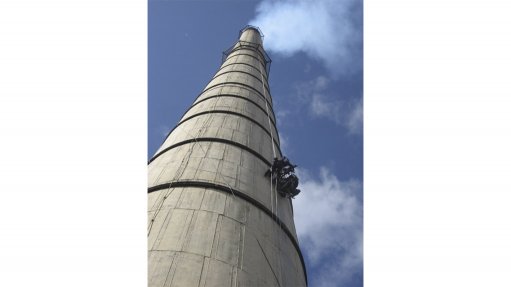
YING AND YANG Skyriders demonstrated the synergy between drone technology and traditional rope access during an inspection project
Drone technology presents a major cost-saving opportunity for companies, compared with traditional methods of inspection, highlights industrial rope-access company Skyriders marketing manager Mike Zinn.
Skyriders’ Elios SkyEye drone is designed specifically for indoor application, enabling the drone to access confined spaces of about 450 mm in diameter, and the drone operator to stand at a safe distance while conducting the inspection.
“The deployment of the Elios SkyEye drone can slash the cost of using a traditional access method, such as scaffolding, by as much as 80%,” he says.
Zinn explains that the Elios SkyEye allows for the rapid and thorough visual inspection of the entire area. Moreover, if any repair work, such as welding or further non-destructive testing, is required, highly qualified and experienced rope-access technicians can be deployed.
“We are able to give clients complete peace of mind throughout fulfilling their specific requirements quickly and efficiently.”
Further, Skyriders undertook inspection work in a petrochemicals environment using the Elios SkyEye drone last month. The scope of work at the refinery entailed the inspection of the boilers, vacuum furnaces and the fluid catalytic cracking unit. Zinn notes that the inspection took less than five hours to complete.
“We introduced a new way of doing inspection work for this refinery and we look forward to doing similar projects with them in the near future.”
Meanwhile, Skyriders demonstrated the synergy between drone technology and traditional rope access during an inspection undertaken at one of the country’s oldest power stations in Mpumalanga.
The fast-track project was undertaken in conjunction with partner company consulting engineers Nyeleti Consulting. The two-part project involved the inspection of two 155-m-high smokestacks.
The external inspection component was carried out by a two-person team deploying high technology drones fitted with high-definition resolution cameras and thermal imaging.
The thermal imaging was carried out very early in the morning, before the sun’s heat
could have an impact on the smokestacks. This was necessary to identify any hot spots that could indicate areas where the internal brick lining of the concrete wind shield had deteriorated, comments Zinn.
In the second part of the project, a four-person rope-access team took core samples from the smokestacks. This involved drilling 100-mm-diameter holes into the concrete and extracting the samples to be submitted for laboratory testing for compression strength and carbonation, besides others.
“While a good visual inspection is essential, and can provide a wealth of information, it is equally important for an engineer to understand the ‘health’ of the concrete, as well as the rebar or reinforcing steel. Both these components provide a good overview of the true condition of the structures.”
Zinn explains that, after the core samples have been extracted, the holes were patched using an approved patching material to ensure the integrity of the structure. Following the receipt of the laboratory results, a detailed report was submitted to the client, highlighting any issues that may require attention.